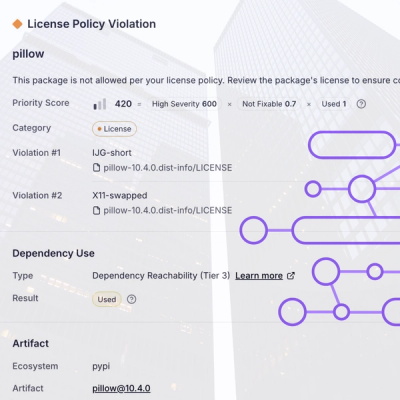
Security News
TC39 Advances 11 Proposals for Math Precision, Binary APIs, and More
TC39 advances 11 JavaScript proposals, with two moving to Stage 4, bringing better math, binary APIs, and more features one step closer to the ECMAScript spec.
cssx-framework
Advanced tools
A CSS driven web framework that compiles semi-standard CSS into HTML content + styles at runtime
CSSX is a web UI framework with file-path routing. You've heard of CSS-in-JS, and CSS pre/post-processors like SASS, LESS, and Tailwind - but now get ready for a whole new world of CSS driven development, with CSSX!
I built CSS because I thought it was an entertaining idea and would parallel the million JS frameworks that exist. It doesn't really have a purpose except to entertain and see if it was possible.
From the terminal, run npx create-cssx@latest or npm create cssx@latest, and follow the prompts to set up a basic template. From there run (npm | yarn | pnpm | bun) install > (npm | yarn | pnpm | bun) start to spin up the local dev environment.
As CSSX is a file-path route based framework, the default template expects each page to be a .cssx file within a ./routes directory. This can be updated by changing the routeDir in the cssx.json file.
Any mixins or shared components that are setup can be stored however you like, and then referenced as imports (@import '{relative_path_to_file}';) relative to the calling file.
.cssx files have roughly the same format as a standard .css file, but with some additional functions like mixins in order to provide functionality for shared component styling.
To render elements on the page, simply write the CSS you require, but include the element tag in the specificity of the class (ie. div.root would render a div element with the class root). Any element attributes you wish to include can be added in the same format as CSS variables nested within the class definition.
In order to define nested elements, just nest the CSS class definitions under the appropriate parent, like you would structure regular CSS.
eg.
div.root {
color: red;
--title: Div Title;
--text: Some text;
button {
border-radius: 8px;
color: blue;
--onclick: alert('Button clicked!');
--text: Click me;
--type: button;
}
}
would become =>
<div class="root" title="Div Title">
Some text
<button onclick="alert('Button clicked!')" type="button">
Click me
</button>
</div>
with the stylesheet
div.root {
color: red;
button {
border-radius: 8px;
color: blue;
}
}
Mixins can be defined with the syntax below:
@mixin mixinName($param1: defaultValue1, $param2: defaultValue2) {
...
}
and referenced as an @include statement: @include mixinName(); (For brevity, the parentheses can be omitted if empty @include mixinName;)
Mixin parameters can be overridden when including in a component, but if defining overrides then all parameters must be defined - ie. either define all of them, or leave them empty. If not all parameters are to be overridden, then the value default can be used as a placeholder: @include mixinName(default, overrideValue);
A mixin can either be defined as a full component, with the element definition at the top level:
@mixin standardButton($backgroundColor: lightgreen, $hoverColor: lightblue, $class: example, $borderRadius: 6px, $type: button) {
button {
background-color: $backgroundColor;
--borderRadius: $borderRadius;
--class: $class;
--type: $type;
&:hover {
background-color: $hoverColor;
}
}
}
div.root {
@include standardButton;
}
or just as the nested styles / attributes / children, depending how you wish to interact with them
@mixin standardButton($backgroundColor: lightgreen, $hoverColor: lightblue, $class: example, $borderRadius: 6px, $type: button) {
background-color: $backgroundColor;
--borderRadius: $borderRadius;
--class: $class;
--type: $type;
&:hover {
background-color: $hoverColor;
}
}
div.root {
button {
@include standardButton;
}
}
Javascript functions can be defined inline for components, and will be transpiled to the appropriate element event attribute.
button.aButton {
--onclick: "console.log('test');";
--type: "button";
--text: "Click me";
}
=>
<button type="button" onclick="console.log('test');">
Click me
</button>
Defining functions across multiple lines is also possible by defining the event attribute values on lines subsequent to the event attribute definition, as outlined in the snippet below. This will then get transpiled into a single line concatenated string on the event attribute.
Note: When doing multiline functions, don't forget your semi-colons to break separate functions up - CSSX just joins the strings with spaces and isn't smart enough to know where semi-colons should go!
button.anotherButton {
--onclick:
"console.log('test');"
"setInterval(() => {"
"document.getElementById('picture-gallery').scrollBy({left: -25, behavior: 'smooth'})"
"}, 100)";
--text: "Click me again"
}
=>
<button class="anotherButton" onclick="console.log('test'); setInterval(() => { document.getElementById('picture-gallery').scrollBy({left: -25, behavior: 'smooth'}) }, 100)">
Click me again
</button>
To make shared functions, simply pull your event attribute definitions out into a mixin, and @include them like a normal mixin.
Note: Mixin params are determined at compile time, so ensure that your mixin functions cater for this.
@mixin testFunction() {
--onclick:
"console.log('test');"
"setInterval(() => {"
"document.getElementById('picture-gallery').scrollBy({left: -25, behavior: 'smooth'})"
"}, 100)";
}
button.anotherButton {
@include testFunction;
--text: "Click me again";
}
CSSX has some built-in function variables to simplify the code needed for event functions. They can be referenced for any event function and will be replaced via string replacement at compile time. The functionality of these built-in functions can be overidden by redefining a variable with the same name within your CSSX.
These are defined below:
const BUILT_IN_FUNCTIONS = {
'$setVariable': 'document.styleSheets[document.styleSheets.length - 1].cssRules[0].style.setProperty',
'$getVariable': 'document.styleSheets[document.styleSheets.length - 1].cssRules[0].style.getPropertyValue',
'$parseObject': 'JSON.parse',
'$stringifyObject': 'JSON.stringify',
}
Example:
button {
--onclick: $getVariable('--object');
--text: "Click";
--type: "button";
}
=>
<button onclick="document.styleSheets[0].cssRules[0].style.getPropertyValue('--object')" type="button">
Click
</button>
All variables used to interact with the UI in CSSX are managed as CSS variables (ie --variable: value;), and need to be defined as immediate children of the root object. As CSSX is a line-by-line framework, and isn't smart enough to understand complex object variables, these need to be defined as single line string values as well (ie --form: {"name": null, "email": null};).
In order to perform any object manipulation, these variables will then need to be parsed to an object first.
An example for alerting an object might be:
div.page {
--form: {"name": null, "email": null};
button {
--onclick: alert($parseObject($getVariable('--form')));
--type: "button";
}
}
FAQs
A CSS driven web framework that compiles semi-standard CSS into HTML content + styles at runtime
The npm package cssx-framework receives a total of 27 weekly downloads. As such, cssx-framework popularity was classified as not popular.
We found that cssx-framework demonstrated a healthy version release cadence and project activity because the last version was released less than a year ago. It has 1 open source maintainer collaborating on the project.
Did you know?

Socket for GitHub automatically highlights issues in each pull request and monitors the health of all your open source dependencies. Discover the contents of your packages and block harmful activity before you install or update your dependencies.

Security News
TC39 advances 11 JavaScript proposals, with two moving to Stage 4, bringing better math, binary APIs, and more features one step closer to the ECMAScript spec.

Research
/Security News
A flawed sandbox in @nestjs/devtools-integration lets attackers run code on your machine via CSRF, leading to full Remote Code Execution (RCE).

Product
Customize license detection with Socket’s new license overlays: gain control, reduce noise, and handle edge cases with precision.